Who
were the Huguenots?
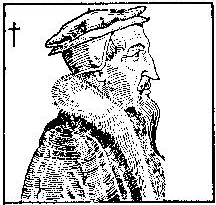 John Calvin (1509
- 1564),
John Calvin (1509
- 1564),
religious reformer.
|
The Huguenots
were French Protestants who were members of the Reformed Church
which was established in 1550 by John
Calvin.
The origin of the name Huguenot is uncertain,
but dates from approximately 1550 when it was used in court cases against
"heretics" (dissenters from the Roman Catholic Church). There is a theory
that it is derived from the personal name of Besançon Hugues, the
leader of the "Confederate Party" in Geneva,
in combination with a Frankish corruption of the German word for conspirator
or confederate: eidgenosse. Thus,
Hugues
plus eidgenot becomes Huguenot, with the intention of associating
the Protestant
cause with some very unpopular politics. |
O.I.A. Roche, in his book The Days of the
Upright, a History of the Huguenots, writes that "Huguenot" is
"a combination of a Flemish
and a German word. In the Flemish corner of France, Bible students who
gathered in each other's houses to study secretly were called Huisgenooten,
or "house fellows," while on the Swiss and German borders they were termed
Eidgenossen, or "oath fellows," that is, persons bound to each other by
an oath. Gallicized into "Huguenot," often used deprecatingly, the word
became, during two and a half centuries of terror and triumph, a badge
of enduring honor and courage."
As nickname and even abusive name it's use
was banned in the regulations of the Edict of Nantes which Henry IV
(Henry of Navarre, who himself earlier was a Huguenot) issued in 1598.
The French Protestants themselves preferred to refer to themselves as "réformees"
(reformers) rather than "Huguenots".
It was much later that the name "Huguenot"
became an honorary one of which their descendants are proud.
A general edict which encouraged the extermination
of the Huguenots was issued on January 29th, 1536 in France. On March
1st, 1562 some 1200 Huguenots were slain at Vassy, France. This
ignited the the Wars of Religion
which would rip apart, devastate, and bankrupt France for the next three
decades.
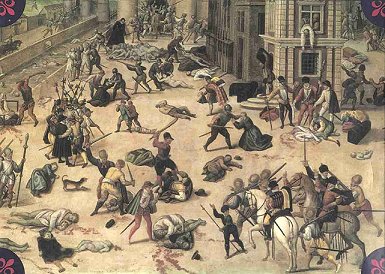 |
St. Batholomew massacre, 1572
Click on image above for
an enlarged view
|
During the infamous St
Bartholomew Massacre of the night of 23/24 August, 1572 more than
8 000 Huguenots, including Admiral
Gaspard de Coligny, Governor of Picardy and leader and spokesman of
the Huguenots, were murdered in Paris. It happened during the wedding of
Henry of Navarre, a Huguenot, to Marguerite de Valois (daughter of Catherine
de Medici), when thousands of Huguenots converged on Paris for the wedding
celebrations.
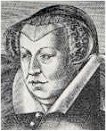
Catherine de
Medici
|
It was Catherine de Medici who persuaded
her weakling son Charles IX to order the mass murder, which lasted three
days and spread to the countryside. On Sunday morning August 24th, 1572
she personally walked through the streets of Paris to inspect the carnage.
Henry of Navarre's life was spared when he pretended to support the Roman
Catholic faith. In 1593 he made his "perilous leap"and abjured his faith
in July 1593, and 5 years later he was the undisputed monarch as King Henry
IV (le bon Henri, the good Henry) of France. |
| When the first rumours of the massacre
reached the Vatican in Rome on 2 September 1572, pope Gregory
XIII was jubilant and wanted bonfires to be lit in Rome. He was persuaded
to wait for the official communication. The very morning of the day that
he received the confirmed news, the pope held a consistory and announced
that "God had been pleased to be merciful". Then with all the cardinals
he repaired to the Church of St. Mark for the Te Deum, and prayed
and ordered prayers that the Most Christian King might rid and purge his
entire kingdom (of France) of the Huguenot plague. |

Pope Gregory XIII
|
On 8 September 1572 a procession of thanksgiving
took place in Rome, and the pope, in a prayer after mass, thanked God for
having "granted the Catholic people a glorious triumph over a perfidious
race" (gloriosam de perfidis gentibus populo catholico loetitiam tribuisti).
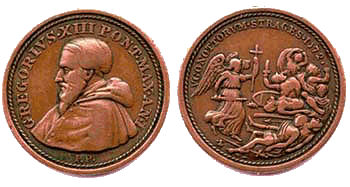 Gregory
XIII engaged Vasari to paint scenes in one of the Vatican apartments of
the triumph of the Most Christian King over the Huguenots. He had a medal
struck representing an exterminating angel smiting the Huguenots with his
sword, the inscription reading: Hugonottorium strages (Huguenot
conspirators). In France itself, the French magistracy ordered the admiral
to be burned in effigy and prayers and processions of thanksgiving on each
recurring 24th August, out of gratitude to God for the victory over the
Huguenots. Gregory
XIII engaged Vasari to paint scenes in one of the Vatican apartments of
the triumph of the Most Christian King over the Huguenots. He had a medal
struck representing an exterminating angel smiting the Huguenots with his
sword, the inscription reading: Hugonottorium strages (Huguenot
conspirators). In France itself, the French magistracy ordered the admiral
to be burned in effigy and prayers and processions of thanksgiving on each
recurring 24th August, out of gratitude to God for the victory over the
Huguenots.
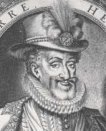
Henry IV, himself a former
Huguenot (as Henry of Navarre)
|
The Edict of Nantes was signed
by Henry IV on April 13th, 1598, which brought an end to the Wars of Religion.
The Huguenots were allowed to practice
their faith in 20 specified French "free" cities. France became united
and a decade of peace followed. After Henry IV was murdered in 1610, however,
the persecution of the "dissenters" resumed in all earnestness under the
guidance of Cardinal Richelieu, whose favourite project was the extermination
of the Huguenots. |

Richelieu, who relentlessly
persecuted the Huguenots.
|
Henry IV's weakling sun, Louis the Thirteenth,
refused them the privileges which had been granted to them by the Edict
of Nantes; and, when reminded of the claims they had, if the promises of
Henry the Third and Henry the Fourth were to be regarded, he answered that
"the first-named monarch feared them, and the latter loved them; but
I neither fear nor love them." The Huguenot free cities were lost one
after the other after they were conquered by the forces of Cardinal Richelieu,
and the last and most important stronghold, La Rochelle, fell in
1629 after a siege lasting a month.

Louis XIV
|
Louis XIV (the Sun King, 1643-1715)
began to apply his motto l'état c'est moi ("I am the state")
and introduced the infamous Dragonnades - the billeting of dragoons
in Huguenot households. He began with a policy of une foi, un loi, un
roi (one faith, one law, one king) and revoked the Edict of Nantes
on 22 October 1685. The large scale persecution of the Huguenots resumed.
Protestant churches and the houses of "obstinates" were burned and destroyed,
and their bibles and hymn books burned. Emigration was declared illegal.
Many Huguenots were burned at the stake. Many Huguenots who did not find
their death in local prisons or execution on the wheel of torture, were
shipped to sea to serve their sentences as galley
slaves, either on French galley ships, or sold to Turkey as galley
slaves. |
A vivid account of the life of galley-slaves
in France is given in Jean Marteilhes's Memoirs of a Protestant,
translated by Oliver
Goldsmith, which describes the experiences of one of the Huguenots
who suffered after the revocation of the Edict
of Nantes.
Every Huguenot place of worship was to
be destroyed; every minister who refused to conform was to be sent to the
Hôpitaux
de Forçats at Marseilles and at Valance. If he had been noted
for his zeal he was to be considered "obstinate," and sent to slavery for
life in such of the West-Indian islands as belonged to the French. The
children of Huguenot parents were to be taken from them by force, and educated
by the Roman Catholic monks or nuns.

Scenes like these were
common during the persecution of the Huguenots in France during the sixteenth
and seventeenth century.
Click on picture above for
enlargement.
At least 250 000 French Huguenots fled
to countries such as Switzerland, Germany, England, America, the Netherlands,
Poland and South Africa, where they could enjoy religious freedom. As many
were killed in France itself. Between 1618 and 1725 between 5 000 and 7
000 Huguenots reached the shores of America. Those who came from the French
speaking south of Belgium, an area known as Wallonia, are generally
known as Walloons (as opposed to Huguenots) in the United
States.
The organised large scale emigration of
Hugenots to the Cape of Good Hope in South Africa occurred during 1688
- 1689. However, even before this large sscale emigration individual Huguenots
such as François Villion (1671) and the brothers François
and Guillaume du Toit (1686) fled to the Cape of Good Hope. In 1692
a total of 201 French Huguenots had settled at the Cape of Good Hope. Most
of them settled in an area now known as Franschhoek ("French Corner"),
some 70 km outside Cape Town, where many farms still bear their original
French names.
A century later the promulgation of the
Edict of Toleration on 28 November 1787 partially restored the civil and
religious rights of the Huguenots in France.

Next page: A brief history of the Huguenots in South Africa
LINKS
 Home
page. Home
page.
|



 Home
page.
Home
page.